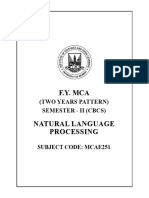SNLP_Syllabus
SNLP_Syllabus
Uploaded by
Ahadit ABCopyright:
Available Formats
SNLP_Syllabus
SNLP_Syllabus
Uploaded by
Ahadit ABCopyright
Available Formats
Share this document
Did you find this document useful?
Is this content inappropriate?
Copyright:
Available Formats
SNLP_Syllabus
SNLP_Syllabus
Uploaded by
Ahadit ABCopyright:
Available Formats
Item 66/29 - Annexure - 25
Course code Course Title L T P C
BCSE419L Speech and Language Processing 3 0 0 3
Pre-requisite NIL Syllabus version
1.0
Course Objectives
1. Be competent with fundamental concepts for natural language processing and
automatic speech recognition
2. To understand technologies involved in developing speech and language
applications.
3. To demonstrate the use of deep learning for building applications in speech and
natural language processing
Course Outcomes
At the end of this course, student will be able to:
1. Describe the importance of different NLP modules in Text processing and
fundamentals of speech production
2. Describe ways to represent speech and text
3. Demonstrate the working of sequence models for text
4. Use signal processing techniques to analyze/represent the speech signal
5. Execute trials of speech/language systems
Module:1 Introduction to Natural Language Processing 7 hours
Overview of NLP - Introduction to Levels of NLP - Morhpology: Derivational &
Inflectional Morphology - POS tagging - Parsing: Shallow and Dependency
Parsing, Semantics:
Word Level Semantics and Thematic roles.
Module:2 Text Preprocessing & Feature Representation 8 hours
Introduction to Corpora, Sentence Segmentation, Stemming: Porter Stemmer, Bag of words
and Vector Space Model, Topic Modeling, N-gram Language Model, Smoothing, Word
Embeddings: Word2Vec, Glove and Fasttext.
Module:3 Applications of NLP-1 6 hours
Sentiment Classification using ML & DL models, Named Entity Recognition - CRF and
LSTMs, Text Summarization - Statistical and Deep Learning models.
Module:4 Applications of NLP-2 4 hours
Machine Translation - Encoder & Decoder Model, Attention Models, Question Answering -
Knowledge based Q&A and Deep Learning models for Q&A.
Module:5 Introduction to Speech Processing 6 hours
Fundamentals of speech production – Perception of sound – Vocal tract model - Phonetics
- Short-Time analysis of the signal – Energy – Zero crossing – Autocorrelation – Short
time Fourier analysis.
Module:6 Feature Representaion of Speech Signal 4 hours
Mel Frequency Cepstral Coeffecients, Perceptual linear prediction (PLP), Linear prediction
cepstral coefficients (LPCC), Gammatone Frequency Cepstral Coefficients (GFCC), i-vector.
Module:7 Automatic Speech and Speaker Recognition 8 hours
Automatic Speech recognition formulation: Isolated word recognition – Large vocabulary
continuous speech recognition - HMM/GMM based speech recognition – DNN/HMM
model
-- CNN based speech recognition - RNN language Models – Evaluation metrics, Speaker
Proceedings of the 66th Academic Council (16.06.2022) 663
Item 66/29 - Annexure - 25
recognition model – Alexa/Google assistant based application development.
Module:8 Contemporary issues 2 hours
Total Lecture hours: 45 Hours
Text Book(s)
1. Dan Jurafsky, James H. Martin “Speech and Language Processing”, Draft of 3rd
Edition,Prentice Hall 2022.
2. Jacob Benesty, M. M. Sondhi, Yiteng Huang "Springer Handbook of Speech
Processing", Springer, 2008.
Reference Books
1. Uday Kamath, John Liu, James Whitaker "Deep Learning for NLP and Speech
Recognition" Springer, ,2019.
2. Steven Bird, Ewan Klein, Edward Loper "Natural Language Processing with Python",
O'Reilly Media. 2009.
3. Ben Gold, Nelson Morgan, Dan Ellis “Speech and Audio Signal Processing: Processing
and Perception of Speech and Music”, John Wiley & Sons, 2011.
Mode of Evaluation: CAT / Written Assignment / Quiz / FAT
Recommended by Board of Studies 09-05-2022
Approved by Academic Council No. 66 Date 16-06-2022
Proceedings of the 66th Academic Council (16.06.2022) 664
Item 66/29 - Annexure - 25
Course code Course Title L T P C
BCSE419P Speech and Language Processing Lab 0 0 2 1
Pre-requisite NIL Syllabus version
1.0
Course Objectives
1. Be competent with fundamental concepts for natural language processing and
automatic speech recognition
2. To understand technologies involved in developing speech and
language applications.
3. To demonstrate the use of deep learning for building applications in speech and
natural language processing
Course Outcome
At the end of this course, student will be able to:
1. Describe the importance of different NLP modules in text processioning and
fundamentals of speech production
2. Describe ways to represent speech and text
3. Demonstrate the working of sequence models for text
4. Use signal processing techniques to analyze/represent the speech signal
5. Execute trials of speech/language systems
Indicative Experiments
1. Installing various packages for text and Speech Processing: NLTK, 3 Hours
Spacy, Speech Recognition etc.
2. POS Tagging and Parsing using various python packages 2 Hours
3. Implementation of BOW, topic models for text representation and 2 Hours
classification
4. Implementing N-gram language models for next word prediction 2 Hours
5. Implementing Word embedding based text classification 2 Hours
6. Implementing CNN for sentiment analysis 2 Hours
7. Implementing RNN for Named Entity recognition 2 Hours
8. Implementing text summarization using deep learning 2 Hours
9. Implementing chatbot using deep learning 2 Hours
10. Implementing machine translation using encoder-decoder 2 Hours
models
11. Developing speech recognition system to recognize voice 3 Hours
commands
12. Developing speech recognition system to recognize 3 Hours
continuous speech
13. Implementing CNN based speech recognition using mel 3 Hours
spectal images
Total Laboratory Hours 30 hours
Text Book(s)
1. Delip Rao, Brian McMahan, “Natural Language Processing with PyTorch: Build
Intelligent Language Applications Using Deep Learning”, 2019, 1st Edition, O'Reilly
Media.
Reference Books
1. Mark Liu, “Make Python Talk: Build Apps with Voice Control and Speech
Recognition ”, 2021, 1st Edition, No Starch Press.
Mode of Evaluation: CAT / Mid-Term Lab/ FAT
Recommended by Board of Studies 09-05-2022
Approved by Academic Council No. 66 Date 16-06-2022
Proceedings of the 66th Academic Council (16.06.2022) 106
5
You might also like
- E-Commerce Website: Major Project ReportDocument19 pagesE-Commerce Website: Major Project ReportAkash NegiNo ratings yet
- Bcse409l Natural-Language-Processing TH 1.1 0 Bcse409lDocument2 pagesBcse409l Natural-Language-Processing TH 1.1 0 Bcse409lSai ChakrinNo ratings yet
- Natural Language Processing Inside Pages 2Document159 pagesNatural Language Processing Inside Pages 2pymparticle458No ratings yet
- Cse4022 Natural-Language-Processing Eth 1.0 37 Cse4022Document2 pagesCse4022 Natural-Language-Processing Eth 1.0 37 Cse4022survey ssNo ratings yet
- Swe1017 NLP SyllabusDocument2 pagesSwe1017 NLP SyllabusRamyasai MunnangiNo ratings yet
- NLP ADocument6 pagesNLP ARAMYA KANAGARAJ AutoNo ratings yet
- Fundamentals of Speech ProcessingDocument2 pagesFundamentals of Speech ProcessingHarsha M VNo ratings yet
- CSE4022 Natural-Language-Processing ETH 1 AC41Document6 pagesCSE4022 Natural-Language-Processing ETH 1 AC41Arkadeepta RoyNo ratings yet
- Speech ProcessingDocument5 pagesSpeech Processingdheeraj.cseNo ratings yet
- Syllabus CM3060 NLPDocument7 pagesSyllabus CM3060 NLPPrasannaNo ratings yet
- CCS369-TEXT AND SPEECH ANALYSISDocument3 pagesCCS369-TEXT AND SPEECH ANALYSISYogesh 02No ratings yet
- intro to NLP Course Outline (Fall-2024)Document4 pagesintro to NLP Course Outline (Fall-2024)abbastayyaba417No ratings yet
- Speech Understanding ContentDocument9 pagesSpeech Understanding ContentChamod KanishkaNo ratings yet
- Deep Learning DSDL32,NLPDocument4 pagesDeep Learning DSDL32,NLPspooja.nmkrvNo ratings yet
- CCS369 TEXT AND SPEECH ANALYSIS - SyllabusDocument4 pagesCCS369 TEXT AND SPEECH ANALYSIS - SyllabusthirushharidossNo ratings yet
- Research Paper 4Document2 pagesResearch Paper 4temp242389No ratings yet
- Course Plan Natural Language ProcessingDocument5 pagesCourse Plan Natural Language ProcessingMalik KashifNo ratings yet
- Ec 518 PDFDocument2 pagesEc 518 PDFAnkit AnuragNo ratings yet
- CCS369Document2 pagesCCS369Karthick SundaramNo ratings yet
- NLP Subject Orientation SH23Document35 pagesNLP Subject Orientation SH23Tejas KorlekarNo ratings yet
- HG3052 CourseOutline SpeechSynthesisRecognition AY2019-20 SEM1 Update Sep10Document6 pagesHG3052 CourseOutline SpeechSynthesisRecognition AY2019-20 SEM1 Update Sep10fungklNo ratings yet
- 6th sem AIML syllabus 2022 schemeDocument53 pages6th sem AIML syllabus 2022 schemeBraham KumarNo ratings yet
- ccs369 Ts A SyllabusDocument3 pagesccs369 Ts A SyllabusUsharani KNo ratings yet
- Brochure CMU NLP 24-08-2022 V13Document13 pagesBrochure CMU NLP 24-08-2022 V13Maria Antonietta RicciNo ratings yet
- TMC 403 (2) Natural Language ProcessingDocument2 pagesTMC 403 (2) Natural Language ProcessingSuraj BishtNo ratings yet
- 2 IPCC - Natural Language ProcessingDocument4 pages2 IPCC - Natural Language Processingarjunbhandary57No ratings yet
- SyllabusDocument2 pagesSyllabusdeadlock1No ratings yet
- Csa4006 Natural-Language-Processing LT 1.0 6 Csa4006Document2 pagesCsa4006 Natural-Language-Processing LT 1.0 6 Csa4006soubhik.pailan2020No ratings yet
- NLP Nanodegree SyllabusDocument11 pagesNLP Nanodegree Syllabusbalthazar shresthaNo ratings yet
- CSE Syl BOS 14-15 Draft-161-188Document28 pagesCSE Syl BOS 14-15 Draft-161-188prasathNo ratings yet
- Natural Language Processing HandoutDocument8 pagesNatural Language Processing HandoutsdfasdNo ratings yet
- Lab Syllabus NLP LabDocument2 pagesLab Syllabus NLP LabSenthilkumar MurugesanNo ratings yet
- Basic Course Material Winter 2015Document19 pagesBasic Course Material Winter 2015ronyiut100% (1)
- 2 - 6N302 Natural Language ProcessingDocument6 pages2 - 6N302 Natural Language ProcessingHarshal LolgeNo ratings yet
- Natural Language Processing With PythonDocument3 pagesNatural Language Processing With PythonsambitNo ratings yet
- Natural Language processing-Regular-HODocument10 pagesNatural Language processing-Regular-HObhavana2264No ratings yet
- AIML - Unit4 HPJDocument31 pagesAIML - Unit4 HPJhanishajadwaniNo ratings yet
- Bhawini NLP PracticalDocument98 pagesBhawini NLP PracticalBhawini RajNo ratings yet
- Bhawini NLP FileDocument100 pagesBhawini NLP FileBhawini RajNo ratings yet
- English BookDocument128 pagesEnglish Bookdishantm008No ratings yet
- Natural Language Processing(Peiii)Document2 pagesNatural Language Processing(Peiii)Punya SriNo ratings yet
- Applied Natural Language ProcessingDocument3 pagesApplied Natural Language Processingkirankohli040600No ratings yet
- NLP Syllabus R21Document2 pagesNLP Syllabus R21Vijay KumarNo ratings yet
- Lecture1Document16 pagesLecture1P.V.Hemavathi VISTASNo ratings yet
- Unit 5Document20 pagesUnit 5Anonymous XhmybKNo ratings yet
- NLP 833Document26 pagesNLP 833bodanif706No ratings yet
- ElectiveDocument10 pagesElectiveveerpunjabagroNo ratings yet
- 21UAD704 - Natural Language ProcessingDocument19 pages21UAD704 - Natural Language ProcessingSenthilkumar MurugesanNo ratings yet
- SPC 2301 - Course OutlineDocument8 pagesSPC 2301 - Course OutlineEddy MakoyoNo ratings yet
- Natural_Language_Processing (NLP)Document32 pagesNatural_Language_Processing (NLP)habtamugebeyawuNo ratings yet
- Lec-1 IntroductionDocument68 pagesLec-1 IntroductionGia ByNo ratings yet
- Non Literary Text MaterialsDocument4 pagesNon Literary Text Materialsmagavina.03No ratings yet
- Case Study On The BuildingDocument15 pagesCase Study On The Buildingutkarshgandhi6543No ratings yet
- Project T Proposal Bangla Alphabet Handwritten Recognition Using Deep Learning.Document5 pagesProject T Proposal Bangla Alphabet Handwritten Recognition Using Deep Learning.Khondoker Abu NaimNo ratings yet
- NLP IAE II Students Blue PrintDocument1 pageNLP IAE II Students Blue Printahmadtaqu38No ratings yet
- Unit 1Document12 pagesUnit 120bq1a4213No ratings yet
- CSCN05C Automata Language TheoryDocument5 pagesCSCN05C Automata Language TheoryJhaze Allestain PalleraNo ratings yet
- NLPDocument2 pagesNLPpriyanshudhaked00No ratings yet
- School of Engineering & Technology Navrachana University, Vadodara, Gujarat, India-391 410 Website: Course Code: Course TitleDocument3 pagesSchool of Engineering & Technology Navrachana University, Vadodara, Gujarat, India-391 410 Website: Course Code: Course Titlechirag malaviyaNo ratings yet
- 326C5BDocument2 pages326C5Bkeerthivasanr869No ratings yet
- Form 1 Pre Observation InformationDocument1 pageForm 1 Pre Observation InformationNoel Jun LingayanNo ratings yet
- Hindi Magal Short Key CodeDocument9 pagesHindi Magal Short Key Codehackman6342No ratings yet
- Client Side Session Handling For AngularDocument8 pagesClient Side Session Handling For AngularHelen ANo ratings yet
- IDOC-Basics-Partner ProfileDocument6 pagesIDOC-Basics-Partner Profileshyamvs2002No ratings yet
- UAI Etika Dan Norma Dalam HI 4 - Filsafat Judaisme (Maimonides)Document25 pagesUAI Etika Dan Norma Dalam HI 4 - Filsafat Judaisme (Maimonides)Dyna Fitria ChaniagoNo ratings yet
- Context Clues - ShakespeareDocument2 pagesContext Clues - ShakespeareYanny WongNo ratings yet
- Lab Management FinalsDocument28 pagesLab Management FinalsspilotaNo ratings yet
- Group 7 Report in Philippine Literature (Alejandro R. Roces)Document21 pagesGroup 7 Report in Philippine Literature (Alejandro R. Roces)marisol lausNo ratings yet
- Module 4-IoT NotesDocument30 pagesModule 4-IoT NotesRakshithaNo ratings yet
- Lecture NotesDocument128 pagesLecture Notesapi-318836863No ratings yet
- Listening TestDocument5 pagesListening TestFranceska FejzoNo ratings yet
- Apple iOSDocument7 pagesApple iOSJustyn Jimenez MoralesNo ratings yet
- A Must Have DBA Cheat SheetDocument33 pagesA Must Have DBA Cheat Sheetsindhu7ramNo ratings yet
- Persuasive Essay OutlineDocument8 pagesPersuasive Essay Outlineafhbebhff100% (2)
- Ssis Data Type Cheat SheetDocument1 pageSsis Data Type Cheat SheetebtrainNo ratings yet
- JuliaPro v0.6.4.1 Package API ManualDocument497 pagesJuliaPro v0.6.4.1 Package API ManualEduardo Henrique de Sousa SalvinoNo ratings yet
- Docs Scrapy Org en LatestDocument354 pagesDocs Scrapy Org en LatestCesar Marinho EirasNo ratings yet
- Writing The Introduction: Agric. 206 (Methods of Agricultural Research)Document10 pagesWriting The Introduction: Agric. 206 (Methods of Agricultural Research)Yhurrie Mae EranNo ratings yet
- Age of Chaucer (1350 - 1450)Document5 pagesAge of Chaucer (1350 - 1450)Chishmish Doll100% (1)
- Yash Shah ResumeDocument2 pagesYash Shah ResumeYash ShahNo ratings yet
- PRESTON 1989 Perceptual DialectologyDocument33 pagesPRESTON 1989 Perceptual DialectologyAmanda Timmen MelloNo ratings yet
- Non-Defining Relative ClauseDocument11 pagesNon-Defining Relative ClausesimatupangcallistaNo ratings yet
- Software Requirement Specification On Web BrowserDocument25 pagesSoftware Requirement Specification On Web BrowserShagun Maheshwari67% (3)
- Polynomials 02Document2 pagesPolynomials 02Manas SinghNo ratings yet
- Analysis ofDocument1 pageAnalysis ofTANBIR RAHAMANNo ratings yet
- The Passive 2Document15 pagesThe Passive 2TweetyandBeastNo ratings yet
- Andrade AdichiesGenealogiesNational 2011Document12 pagesAndrade AdichiesGenealogiesNational 2011Khyati ParasharNo ratings yet
- Solucionario AltamarDocument16 pagesSolucionario AltamarMARI CARMEN SANCHEZ RUBIONo ratings yet
- FBX51CDocument1 pageFBX51Cshinsuke1377462688No ratings yet

























































































